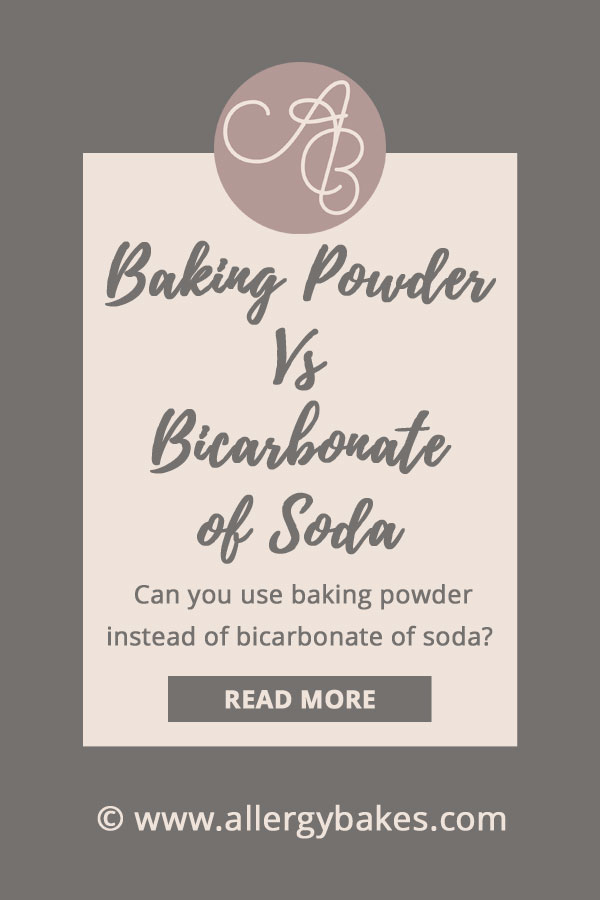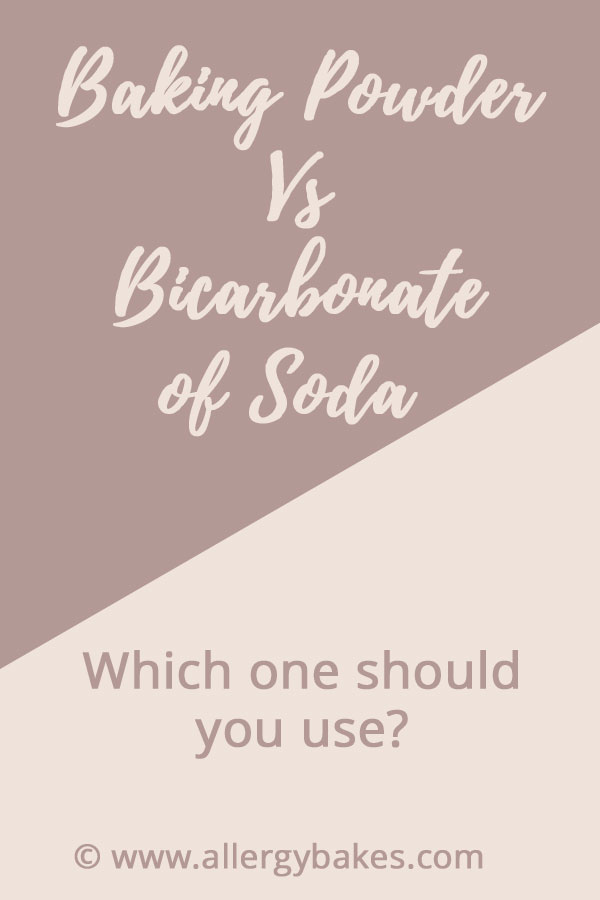Have you ever seen a recipe that calls for baking powder and used bicarbonate of soda instead? And then wondered why your baking didn’t turn out how you wanted it to?
Or wondered why it matters whether a recipe calls for bicarbonate of soda or baking powder? This article will answer your questions on baking powder vs bicarbonate of soda.

What’s the Difference Between Baking Powder and Bicarbonate of Soda?
First things first, bicarbonate of soda is the same thing as baking soda!
Both baking powder and bicarbonate of soda are leavening agents. This means they produce carbon dioxide and cause baked goods to rise. They both produce a light texture and crumb.
Baking powder contains bicarbonate of soda but they’re not the same thing.
Sometimes recipe requires both bicarbonate of soda and baking powder. This is because want the most powerful acid neutralizing and leavening effects. It’s good for cookie dough that you want to store overnight.
Bicarbonate of soda
Bicarbonate of soda is made from sodium bicarbonate. To activate it, it needs to be mixed with an acidic ingredient. As soon as you mix the bicarbonate of soda and acid, you need to put it in the oven asap as the reaction starts immediately. If you leave it to sit on the side for a while, when you bake it, they’ll be flat.
If there’s too much bicarbonate of soda leftover in the recipe, it can taste bitter and metallic e.g. it only needs ¼ tsp and you used ½ tsp. And if no acid is used, you get a metallic taste.
Bicarbonate of soda is 4x stronger than baking powder. For example, in 1 cup of gluten-free flour, you would need 1 tsp of baking powder to produce a similar effect of ¼ tsp bicarbonate of soda.
Bicarbonate of soda results in a darker, crisper bake. And helps to create a lovely brown colour.
Baking Powder
Baking powder has sodium bicarbonate in it, plus an acidic ingredient (like cream of tartar) and a drying agent (usually a starch). Because it contains starch, you need to check your baking powder to make sure it’s gluten-free.
You can get single-acting baking powder and double-acting baking powder although double-acting is more common. Single-acting means that as soon as you mix the baking powder with moisture, the reaction will start so you need to put the batter or dough in the oven immediately. Double-acting means that the 1st reaction occurs when you mix it with moisture and the 2nd reaction occurs when you bake it; therefore, you can leave it on the side for a time.
Baking powder has a neutral taste.
Can You Use Baking Powder in Place of Bicarbonate of Soda and Vice Versa?
You can’t just swap them out because they need different environments to work.
It’s much easier to buy both and use them. Your recipe is more likely to turn out right if you use the correct leavening agent. Trying to substitute them is complicated.
Make your own baking powder:
Mix 1 part bicarbonate of soda + 2 parts cream of tartar + 1 ½ parts cornstarch
Quick differences:
Bicarbonate of soda:
- Needs acid to activate it
- Activates straight away once mixed with acid
Baking powder:
- Needs moisture to activate it, doesn’t need acid
- Usually actives twice, once when it’s first mixed with liquid and 2nd when it’s baked
How Do I Test if They’re Still Active or Working?
It’s very easy to test if baking powder and bicarbonate of soda are still working.
To make them last a long time, store them in a cool, dry place.
Testing if baking powder is still active:
Add ½ tsp of baking powder to a bowl or mug and add 2-3 tbsp of warm water. Mix this together. If it fizzes, your baking powder is still working. If nothing happens, buy new baking powder.
Seeing if bicarbonate of soda is active:
Add ½ tsp of bicarbonate of soda to bowl or mug and add 2-3 tbsp of gluten-free vinegar or lemon juice. If it bubbles, your bicarbonate of soda is still active. If nothing happens, buy new bicarbonate of soda.
What Acidic Ingredients Activate Bicarbonate of Soda?
As bicarbonate of soda requires an acidic ingredient to activate it, here is a list of common acidic ingredients.
- Applesauce
- Brown sugar
- Cream of tartar
- Dairy-free buttermilk
- Dairy-free chocolate
- Dairy-free sour cream
- Dairy-free yogurt
- Gluten-free vinegar
- Honey
- Lemon juice
- Molasses
- Natural cocoa powder (not Dutch-processed as that’s alkaline i.e. nonacidic)
Tips and Advice
If muffins or cupcakes don’t bake high, don’t double the leavening agent. This will cause them to balloon up and spill over as there’s too much carbon dioxide.
Air bubbles are formed during creaming, mixing, kneading, whipping, beating, etc. Baking powder and bicarbonate of soda enlarge these air bubbles.
If your cake dips slightly:
The cake might have too much leavening. If it uses baking powder, reduce it by ¼ tsp next time. If the recipe uses bicarbonate of soda, reduce it by 1/16 tsp when you next make the cake.
If your cake domes:
It may not have enough baking powder or bicarbonate of soda. Increase the baking powder by ¼ tsp. If bicarbonate of soda, increase it by 1/16 tsp.
Common ratios:
Baking powder = 1 cup gluten-free flour + 1 tsp baking powder
Bicarbonate of soda = 1 cup gluten-free flour + ¼ tsp bicarbonate of soda

Conclusion
Baking powder and bicarbonate of soda aren’t the same things. Baking powder doesn’t need an acidic ingredient to work while bicarbonate of soda does.
What questions do you have about allergy-friendly baking?
For more baking tips, check out the Ultimate Guide to Baking Substitutions article here

Leave a Reply